- Home
- About
- Map
- Trips
- Bringing Boat West
- Migration West
- Solo Motorcycle Ride
- Final Family XC Trip
- Colorado Rockies
- Graduates' XC Trip
- Yosemite & Nevada
- Colorado & Utah
- Best of Utah
- Southern Loop
- Pacific Northwest
- Northern Loop
- Los Angeles to NYC
- East Coast Trips
- Martha's Vineyard
- 1 Week in Quebec
- Southeast Coast
- NH Backpacking
- Martha's Vineyard
- Canadian Maritimes
- Ocracoke Island
- Edisto Island
- First Landing '02
- Hunting Island '02
- Stowe in Winter
- Hunting Island '01
- Lake Placid
- Chesapeake
- Provincetown
- Hunting Island '00
- Acadia in Winter
- Boston Suburbs
- Niagara Falls
- First Landing '99
- Cape Hatteras
- West Coast Trips
- Burning Man
- Utah Off-Roading
- Maui
- Mojave 4WD Course
- Colorado River Rafting
- Bishop & Death Valley
- Kauai
- Yosemite Fall
- Utah Off-Road
- Lost Coast
- Yosemite Valley
- Arizona and New Mexico
- Pescadero & Capitola
- Bishop & Death Valley
- San Diego, Anza Borrego, Joshua Tree
- Carmel
- Death Valley in Fall
- Yosemite in the Fall
- Pacific Northwest
- Utah Off-Roading
- Southern CA Deserts
- Yosemite & Covid
- Lake Powell Covid
- Eastern Sierra & Covid
- Bishop & Death Valley
- Central & SE Oregon
- Mojave Road
- Eastern Sierra
- Trinity Alps
- Tuolumne Meadows
- Lake Powell Boating
- Eastern Sierra
- Yosemite Winter
- Hawaii
- 4WD Eastern Sierra
- 4WD Death Valley +
- Southern CA Deserts
- Christmas in Tahoe
- Yosemite & Pinnacles
- Totality
- Yosemite & Sierra
- Yosemite Christmas
- Yosemite, San Diego
- Yosemite & North CA
- Seattle to Sierra
- Southwest Deserts
- Yosemite & Sierra
- Pacific Northwest
- Yosemite & South CA
- Pacific Northwest
- Northern California
- Southern Alaska
- Vancouver Island
- International Trips
- Index
- Tips
- Books
- Photos/Videos
- Search
- Contact
Ayutthaya, Thailand
Sunday, March 18, 2018 - 9:45am by Lolo
50 miles and 1.5 hours from our last stop - 1 night stay
Travelogue
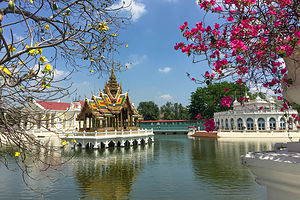 Bang Pa In - the Royal Summer ResidenceWe said our farewells to Bangkok and began our journey north to the historic city of Ayutthaya, the 14th-century capital of the kingdom of Siam, the remains of which are so culturally significant that it has been designated a UNESCO World Heritage Site.
Bang Pa In - the Royal Summer ResidenceWe said our farewells to Bangkok and began our journey north to the historic city of Ayutthaya, the 14th-century capital of the kingdom of Siam, the remains of which are so culturally significant that it has been designated a UNESCO World Heritage Site.
However, we knew enough about the pace of a Gate1 tour by now to expect more than just one amazing highlight per day. Today, there would be three.
Our first stop was Bang Pa In, the summer palace of the kings of Thailand, about 40 miles north of Bangkok along the banks of the Chaopraya River.
Since this is a royal site, the dress code is even stricter than that for entering a temple. Both men and women have to wear long pants and shirts with sleeves - no knees or shoulders, please. No bare feet are allowed either, so if you’re wearing sandals, you must wear sox.Two in our group were pulled aside for inappropriate attire - one woman with lycra tights with mesh and the other with a long sleeve shirt with holes cut out on the shoulder. Fortunately, there was a booth near the entrance that sold or lent clothes to properly cover up. The woman with the tights bought a pair of “elephant pants” for 100 baht, about $3.50 in U.S. dollars. They were so cute that I went in to buy Herb and me a pair. He looked at them a little skeptically, but he eventually came around to calling them his favorite loungewear.
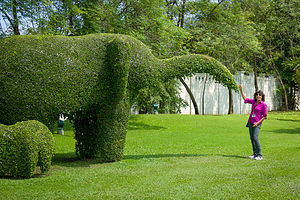 Lolo playing with the elephants at Bang Pa InThe palace grounds are lovely. One of my favorite spots was a large lawn, with a small herd of topiary elephants - even a baby one. I even went up and pet one’s trunk.
Lolo playing with the elephants at Bang Pa InThe palace grounds are lovely. One of my favorite spots was a large lawn, with a small herd of topiary elephants - even a baby one. I even went up and pet one’s trunk.
The buildings are laid out alongside a lovely pond, lined with formal plantings. The original palace was built by King Prasat Thong in 1632 when Thonburi was still the capital of Thailand. The buildings fell into disuse for a long period, but were revived by Rama IV in the 19th century. Most of the buildings as they stand today were created by his successor, Rama V, who also expanded the area into the magnificent sprawling Versaillesque gardens in the late19th century.
The palace is very European in design. During the mid-1800s, there was a conscious effort on the part of King Rama IV to modernize and adopt western customs and styles in order to fend off attempts to colonize them. As a result, from that point forward, you often see a mix of western and Thailand architectural styles. To learn more about this period of Siam’s history, I would recommend watching the movie, The King of Siam.
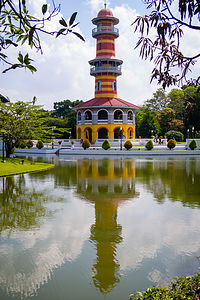 King Rama V's Lookout TowerI think one of the loveliest views in the palace complex is from the gardens looking out at the Thai-style pavilion in the middle of the pond. This is actually the only example of classical Thai architecture within the palace grounds, and has the rather daunting name, “The divine seat of personal freedom.”
King Rama V's Lookout TowerI think one of the loveliest views in the palace complex is from the gardens looking out at the Thai-style pavilion in the middle of the pond. This is actually the only example of classical Thai architecture within the palace grounds, and has the rather daunting name, “The divine seat of personal freedom.”
King Rama V also built a colorful lookout tower for viewing the surrounding countryside. It is called Ho Withun Thasana (or sages lookout). We were allowed to climb the spiral stairs to the top, but only after respectfully removing our shoes. From the balcony that encircled the top, there were wonderful views of the palace grounds.
If I were King, I certainly would want to spend my summer vacations here. However, the palace is no longer used as a royal summer residence, but rather just for special state occasions.
Before continuing on to the historic city of Ayutthaya, the main event of the day, we checked into the Kantary Hotel where Udom granted us 2 hours of free time. The rooms were huge - actually they were suites complete with living room and kitchen. This building was obviously originally planned to be rented as condominiums, but for whatever reason, was now a really nice hotel.
Avoiding the temptation to use our free time napping, we headed to the hotel pool. I forget if I mentioned what the weather in Thailand is like even in March - humid and in the 90s, so an afternoon dip was extremely refreshing.
Before we knew it, we were back on the bus headed to the Ayutthaya Historic Park to see the ruins of Siam’s second capital.
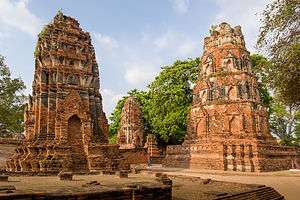 Khmer-style prangs in AyutthayaFirst, some general background. The historic city of Ayutthaya, founded in 1350, flourished from the 14th to the 18th century. Strategically located on an island surrounded by three rivers, Ayutthaya grew to be one of the world’s largest urban areas and a center of global diplomacy and commerce. The power and glory of this once flourishing city came to an end in 1767 when it was attacked by the Burmese army, burning it to the ground and forcing its inhabitants to flee. The city was never rebuilt and is now an extensive archaeological ruin.
Khmer-style prangs in AyutthayaFirst, some general background. The historic city of Ayutthaya, founded in 1350, flourished from the 14th to the 18th century. Strategically located on an island surrounded by three rivers, Ayutthaya grew to be one of the world’s largest urban areas and a center of global diplomacy and commerce. The power and glory of this once flourishing city came to an end in 1767 when it was attacked by the Burmese army, burning it to the ground and forcing its inhabitants to flee. The city was never rebuilt and is now an extensive archaeological ruin.
The site we were visiting is called Wat Mahathat and it was one of the most important temples in the Ayutthaya Kingdom. In one short bus ride, we had left Thailand’s present push to modernity and been thrust into its past. It was unlike anything we had seen so far.
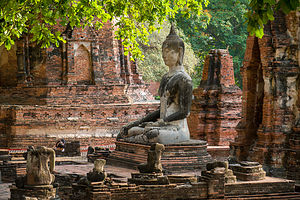 Mat Mahathat in AyutthayaThe temple was constructed in 1374 by King Boromma Rachathirat I. The design of the Wat Mahathat followed the concepts of the ancient Khmer mountain temples of Angkor in Cambodia, which featured a large central tower, called a prang, standing on an elevated platform, surrounded by four subordinate corner prangs, forming a quincunx, kind of like the number 5 on a dice.
Mat Mahathat in AyutthayaThe temple was constructed in 1374 by King Boromma Rachathirat I. The design of the Wat Mahathat followed the concepts of the ancient Khmer mountain temples of Angkor in Cambodia, which featured a large central tower, called a prang, standing on an elevated platform, surrounded by four subordinate corner prangs, forming a quincunx, kind of like the number 5 on a dice.
A tower can mean many things, so I guess I can best describe these rather unique ones as multi-tiered, with each layer receding in size as it went up. Constructed of laterite (a reddish clayey material) and brick, they were reddish in color and richly carved with arches and columns. Their purpose was to enshrine Buddha relics. The upper part of the central prang collapsed in the early 20th century, so only the base remains.
There are several larger than life-sized seated buddha statues throughout the temple. However, by far the coolest and most photographed representation of the Buddha is the head of a stone Buddha entwined in the roots of a tree. No one knows how it got there, but there are several theories. One is that the tree simply grew around the Buddha head during the time when the temple lay abandoned and overgrown. Another theory is that a thief moved the head away from the main temple to hide it, but never returned to retrieve it.
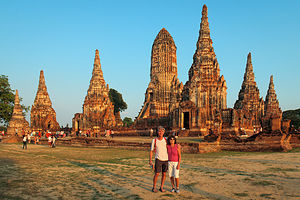 Chai Watthanaram TempleWhile we were wandering the grounds, we met two lovely young ladies dressed in ceremonial Thai clothing. When they saw us admiring their costumes, they offered to pose for a photo with the temple ruins in the background. Of course, I volunteered Herb to pose with them, which makes two days in a row that I have him grinning like a loon between girls one third his age.
Chai Watthanaram TempleWhile we were wandering the grounds, we met two lovely young ladies dressed in ceremonial Thai clothing. When they saw us admiring their costumes, they offered to pose for a photo with the temple ruins in the background. Of course, I volunteered Herb to pose with them, which makes two days in a row that I have him grinning like a loon between girls one third his age.
Udom wasn’t done with us yet, so we were loaded back on the bus and transported a short distance to the Chai Watthanaram Temple, set along the banks of the Chao Phraya River - the same river we had dined beside on our first night in Bangkok. He promised us that the lighting on this temple near sunset would be phenomenal.
There was some sort of festival or event going on so we almost weren’t able to park the bus. However, Udom is not easily daunted, and found a way to make it happen.
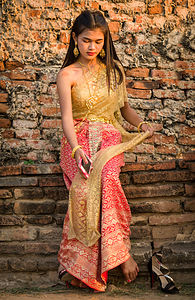 Traditional Thai dress at Chai Watthanaram TempleThe temple complex looked a lot like the one we had just left, but bigger and better preserved, perhaps because it was three centuries younger than Wat Mahathat. It was built in 1630 by King Prasat Thong, the same ruler that build the original summer palace that we visited yesterday morning, Bang Pa In. Like Wat Mahathat, it was built in the Khmer style, with a larger central prang surrounded by smaller prangs on each of its corners. Built of the same materials (laterite and brick), it too was reddish in color, even more pronounced in the evening light.
Traditional Thai dress at Chai Watthanaram TempleThe temple complex looked a lot like the one we had just left, but bigger and better preserved, perhaps because it was three centuries younger than Wat Mahathat. It was built in 1630 by King Prasat Thong, the same ruler that build the original summer palace that we visited yesterday morning, Bang Pa In. Like Wat Mahathat, it was built in the Khmer style, with a larger central prang surrounded by smaller prangs on each of its corners. Built of the same materials (laterite and brick), it too was reddish in color, even more pronounced in the evening light.
It’s not a word I use often, but I would have to say that Chai Watthanaram in the evening light was magical, made all the more so by the friendly and beautiful Thai people, many of whom were dressed in colorful traditional Thai clothing.
Udom explained to us that the new king, Rama X, is encouraging his people to take pride in their heritage by dressing, on special occasions, in the country’s traditional attire. However, an even greater impetus comes from an unlikely source - a TV soap opera called “Love Destiny,” set during the 17th century reign of King Narai the Great (Rama III). Many of the scenes from the show take place in Ayutthaya, so many Thais, both men and women, come to this Wat dressed in traditional garb to take selfies against the backdrop of the ruins.
I think King Prasat Thong would have approved.
- ‹ previous
- 2 of 7
- next ›
Ayutthaya location map in "high definition"
Javascript is required to view this map.
